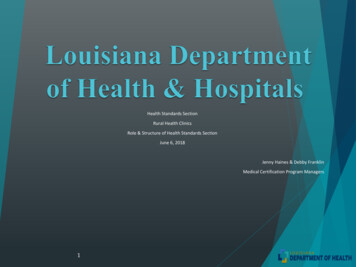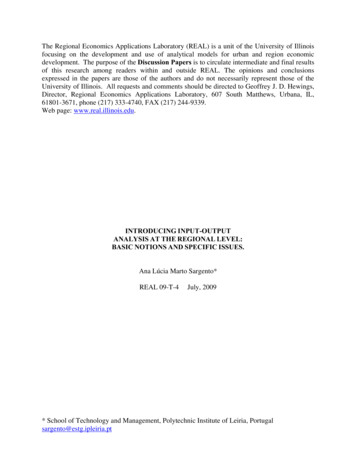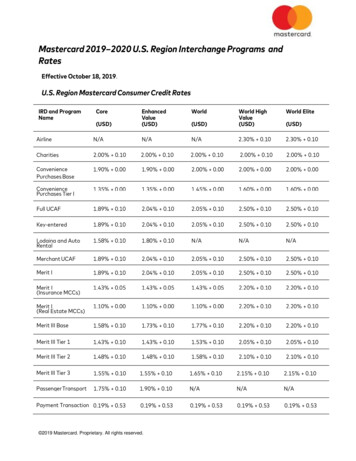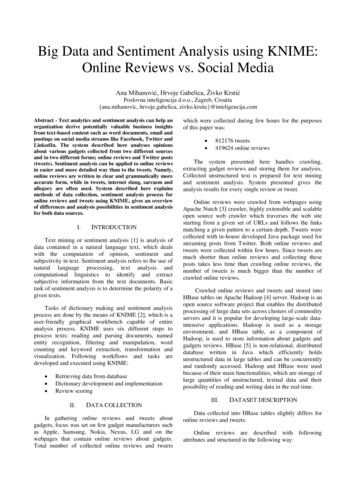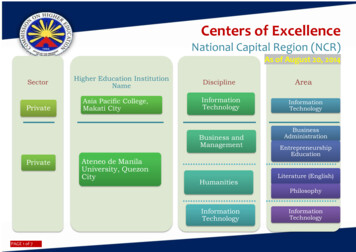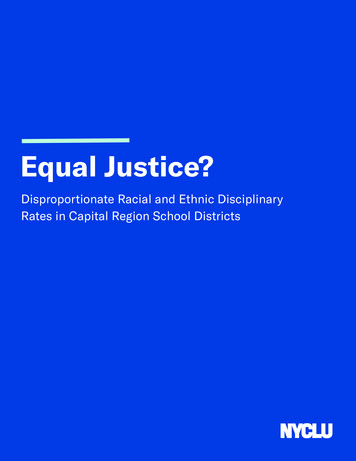
Transcription
Equal Justice?Disproportionate Racial and Ethnic DisciplinaryRates in Capital Region School Districts
EXECUTIVE SUMMARYThe most recent statistics published by the U.S. Department of Education’s Office for CivilRights show that, in a large number of Capital Region school districts, students of color aredisciplined at higher rates—often much higher rates—than white students.These findings reflect a similar pattern found throughout the United States, in which Blackstudents are over-represented in suspensions even though research has shown that Blackstudents are no more likely to misbehave than white students.1These local disparities appear in all types of school districts: urban, suburban and rural.The analysis that follows documents this unequal treatment by assembling disciplinarystatistics for 75 school districts in the eight counties covered by the Capital Region Chapterof the New York Civil Liberties Union (NYCLU): Albany, Columbia, Greene, Rensselaer,Saratoga, Schenectady, Warren, and Washington.These data are extracted from the Civil Rights Data Collection (CDRC), released every twoyears by the Department of Education.2The major city school districts in our region—Albany, Troy, Schenectady, SaratogaSprings—all exhibit higher rates of discipline for minority students than for white students.According to the federal statistics, for example, the 120 Black students in the SaratogaSprings school district are 9.31 times more likely to be suspended than the district’s 5,726white students. Smaller urban districts such as Hudson and Catskill also record higherrates of discipline for students of color. The demographic make-up of the district does notappear to make a difference when it comes to disciplining students of color atdisproportionate rates.Many suburban districts, including those often cited for their “good schools,”disproportionately discipline students of color. In the Burnt Hills/Ballston Lake district, forexample, the 38 Black students are more than ten times as likely to receive out-of-schoolsuspensions as the district’s 2,873 white students. Bethlehem, Niskayuna, Queensbury,East Greenbush, Schalmont and Mohonasen all exhibit suspension rates for their Blackstudents that are between four and ten times higher than for white students.Four suburban districts also exhibit disproportionate suspension rates for Latinx students(referred to in the federal data as Hispanic). North Colonie, Scotia-Glenville, Queensburyand Ravena-Coeymans-Selkirk are two-and-a-half to seven times more likely to suspendLatinx students than white students.For a review of the literature on this subject, see: Gordon, Nora, “Disproportionality in student discipline:Connecting policy to research.” Posted online, January 18, 2018 research/12Access online at https://ocrdata.ed.gov
Given the segregated nature of our communities, many of the smaller, rural school districtsin the Capital Region have so few minority students that meaningful inferences cannot bedrawn from their statistics. For example, the CRDC reports that only two school districts inWarren County—Queensbury and Glens Falls—enroll more than 30 Black students andonly one district in Washington County—Hudson Falls—enrolls more than 30 Blackstudents. This lack of school diversity, in itself, is troubling.METHODOLOGYThe CRDC data provide a highly granular picture of the state of education across thecountry. This database covers the approximately 96,400 public schools and 17,300 publicschool districts in the United States. Every district submits hundreds of data points for itsschools, including such statistics as: access to advanced placement courses, results onSAT/ACT tests, staff salaries, types of pre-school programs, percentage of first-yearteachers, enrollment demographics and—most importantly for the purposes of this analysis—disciplinary outcomes disaggregated by race and ethnicity. The statistics upon which thisreport is based are drawn from the most recent CRDC, which covers the 2015-2016 period.We have focused our attention specifically on out-of-school suspensions (OSS), partlybecause they occur in such large numbers and are often the default disciplinary tool insome school districts. During the 2016-2017 school year alone, school districts in New Yorkstate handed out more than 66,000 out-of-school suspensions. Such suspensions are drasticsanctions in any student’s school career. Studies have shown that suspensions not only failto curb disruptive behavior, but also are related to future undesirable outcomes such asdropping out of school and becoming enmeshed in the criminal justice system.We did not examine detentions or in-school suspensions, since their severity and duration—even their definition—may vary from district to district.HIGHLIGHTS Districts with at least 30 or more Black students are, on average, 3.85 times(median: 3.57) more likely to suspend Black students than white students. Manydistricts far exceed the average. As noted above, in the Burnt Hills/Ballston Lakeschool district, suspensions are 10.12 times higher for Black students than whitestudents. In Saratoga Springs, such suspensions are 9.31 times higher; inQueensbury, 9.28; in Niskayuna, 6.46; in Schuylerville, 5.78; in Guilderland, 4.75,and in Bethlehem, 4.28. Of the 32 school districts in the Capital Region thatenroll at least 30 Black students, ONLY ONE—South Glens Falls—suspended white students at a higher rate than Black students.
Districts with at least 30 or more Latinx students suspend those students at a rate1.51 times higher (median:1.49) than white students. Districts with Latinxsuspension rates at least twice as high as those for white students include:Queensbury, 4.34 times higher; Scotia-Glenville, 3.25; Saratoga Springs, 3.03; NorthColonie, 2.71; Glens Falls, 2.43; Rensselaer, 2.29; Cairo-Durham, 2.11; Guilderland,2.06. Of the 36 school districts in the Capital Region that enroll at least 30Latinx students, only seven suspend white students at a higher rate thanLatinx students. Students who identify themselves as being of two or more races or ethnicities mayidentify and be perceived as students of color and may be the focus of disciplinarydisparities. In the 30 school districts that enroll at least 30 students of two or moreraces, such students receive out-of-school suspensions, on average, 2.43 times(median 2.04) more often than white students. Of the 33 school districts havingat least 30 such students, only two districts—Mohonasen and Glens Falls—suspend such students at rates lower than white students.Statistics Without Context Can Be MisleadingEven when a district does not exhibit substantial differences between the rates at which itsuspends students of color compared with white students, it is not always a salutary sign.Some districts may employ suspensions at high rates for all student groups. InSchenectady, for example, the suspension ratios of white vs. Black students, white vs.Latinx students, and white vs. multi-racial students are below the overall averages for theeight-county Capital Region. Black students are 2.11 times more likely to receivesuspensions than white students; Hispanic students are 1.33 times more likely, and multiracial students are 1.37 times more likely. These figures, however, mask the fact thatsuspension rates for all Schenectady students are extremely high: 13.69% of the district’swhite students received out-of-school suspensions in the 2015-2016 period; the rate forBlack students was 28.93%, for Hispanic students 18.17% and for multi-racial students18.70%. In sum, the district’s 9,549 students received 1,723 suspensions.Schenectady is not alone. Other districts in which white students have comparatively highOSS rates include Albany, Cohoes, Watervliet, Berkshire, Hudson, Catskill, Lansingburgh,Troy, Glens Falls and Hudson Falls. In such districts, disciplinary disparities betweenstudents of color and white students may not appear to be as great as they are in otherdistricts simply because the suspension rates for all classes of students are high.
RECOMMENDATIONSMerely confronting a problem—while a necessary first step—does not ameliorate it. TheNYCLU has the following recommendations for curtailing suspensions, decreasing racialdisproportionality in school discipline, and curbing the damage that suspensions inflict onstudents’ school careers: End Zero Tolerance DisciplineEvery student is different and every set of circumstances is different. Blanket zerotolerance policies compel principals to issue suspensions as their first and only option whenaddressing certain types of behavior. We recommend districts remove zero tolerancerequirements from their Codes of Conduct, ensuring that educators are able to exercisediscretion and kids are able to recover from their mistakes without automatically facingsuspension. Principals and teachers should be trained in proven-effective positiveinterventions, which should be attempted before and instead of invoking suspension. Use Positive Alternatives to Suspension when AppropriateTraining in restorative justice, positive behavior interventions, and conflict resolutionshould be mandated for all administrators, teachers, parent coordinators and schoolresource officers in order to create a culture of trust, support and empathy. Studies haveshown that students who participate in alternatives to punitive discipline, such as conflictresolution, counseling or restorative practices, are happier and more successful at school.These strategies work. After inaugurating restorative justice policies targeting suspension,rates of suspensions for Black and Latino students at Rochester’s East High School droppedmore than 75%.3Also, students need improved access to guidance counselors, social workers and/or schoolpsychologists so that valuable interventions can take place both before and after a studentbreaks a rule. Currently, there are thousands more law enforcement in our nation’s publicschools than social workers.4 In New York State, there are approximately 350 students toThe New York Equity Coalition, “STOLEN TIME: New York schools disproportionately impose out-of-schoolsuspensions on Black students,” 2018, p.3. Available online at: e.pdf3American Civil Liberties Union, “Cops and No Counselors: How the Lack of School Mental Health Staff IsHarming Students,” 2019. Available online at: https://www.aclu.org/sites/default/files/field document/030419acluschooldisciplinereport.pdf4
every guidance counselor. Districts should prioritize the hiring of these supportprofessionals when possible. Protect Students’ Constitutional Rights in Suspension HearingsIn any case when a school feels it has no option other than to impose a suspension, it isimportant that students’ rights are honored throughout the process. Students and theirparents often are not aware of these due process rights. This results in significantviolations yielding one-sided hearings, unnecessary “no contest” pleas, missed opportunitiesfor students to defend themselves, and irregularities in the hearing process such as anadministrator acting as both advocate and witness for the school.To accommodate parents’ work schedules, districts should allot time during evenings andweekends for suspension hearings. Too often, students waive their rights to hearingsbecause their parents are unable to attend.In addition, school districts should not seek exceptionally long suspension periods, andshould ensure that students receive their school work for credit, and are able to take exams,while suspended. Increase Transparency Surrounding Discipline and Safety PracticesSchool districts are not always forthcoming about their disciplinary guidelines or thenumber and type of violations for which students are suspended. Such data should alwaysbe accessible and should be provided to the public on a regular basis, as in frequent reportsby the board of education or in district newsletters. The transparent availability of suchstatistics—including, for example, the number of suspensions, expulsions, and referrals tolaw enforcement, and the frequency of physical restraint--allows for public input ondistricts’ disciplinary practices. It also provides a platform for the district to acknowledgeand address racial disparities in discipline.In addition, districts should ensure that their Codes of Conduct are accessible andunderstandable to students and families, including in languages other than English.Discipline codes should not be vague or subject to interpretation. Students must be onnotice about the types of behaviors that can get them in trouble. Root Out Systemic Implicit BiasDistricts must enact rigorous measures to uncover and ameliorate implicit bias amongadministrators, teachers and support staff. “White privilege” can be a real and destructiveforce even among the most well-meaning people. If we are to reduce the number ofdisproportionate suspensions inflicted on students of color, it is crucial that school
personnel at all levels receive regular, structured in-service training to uncover implicitbias.In addition, districts should adopt culturally relevant curricula. These ensure that teachersand students are exposed to texts and materials that are inclusive of students from allbackgrounds.SCHOOL DISTRICT OUT-OF-SCHOOL SUSPENSIONS (OSS) BY COUNTYAS REPORTED IN CRDC, 2015-2016(NOTE: The CRDC disaggregates disciplinary statistics into the following categories:“American Indian or Alaska Native,” “Asian,” “Native Hawaiian or Other Pacific Islander,”“Black or African American,” “Hispanic or Latino of any race,” “White” and “Two or moreraces.” In its database, the CRCD abbreviates these terms respectively to: AME, ASI, HIPAC, BLA, HIS, WHI and TWO. In our district-by-district compilation below we have, forpurposes of clarity and conciseness, used the following terms: Native American, Asian,Hawaiian/Pacific Islander, Black, Hispanic, White, and Two or More Races.In some cases, there may appear to be discrepancies between the number of suspensionsreported for students of a particular ethnicity or racial category and the rate of suspensionsrecorded for that same category. These differences may arise from rounding or from adistrict’s privacy protection policies or from the fact that some statistical categories includestudents with special needs, while others do not. Of course, anomalies may also arise fromreporting errors on the part of school districts or the Department of Education. In all cases,we endeavor to report raw numbers and suspension rates as they appear in the CRDC.)ALBANY COUNTYAlbanyTotalTotal Student PopulationNumber of OSSOSS Rate9,469TotalTotal Student PopulationNumber of OSSOSS ckHispanicWhite811764365.00%Two ormoreraces48713629.25%Two ormoreraces7
BethlehemTotalTotal Student PopulationNumber of OSSOSS 8%BlackHispanicWhiteTwo ormoreraces4425.00%CohoesTotal Student PopulationNumber of OSSOSS RateTotalNativeAmericanAsian1,9431222TotalTotal Student PopulationNumber of OSSOSS Rate407TotalTotal Student PopulationNumber of OSSOSS Rate4,874Hawaiian/PacificIslander2Green nder6598661.01%Two ormoreraces1011918.81%Two ormoreraces25626.09%Two anHawaiian/PacificIslanderTwo ormoreracesTotal Student Population257482791675Number of OSS42OSS Rate5.33%2.78%* Menands enrolls only K-8 students, who then may attend schools in the North Colonie, South Colonie, Watervlietand Green Island school districts, as well as TechValley High School, under tuition agreements.TotalTotal Student PopulationNumber of OSSOSS Rate5,521North %3,923972.52%Two ormoreraces194105.26%
TotalTotal Student PopulationNumber of OSSOSS Rate1,870TotalTotal Student PopulationNumber of OSSOSS Rate5,194TotalTotal Student PopulationNumber of OSSOSS n/PacificAmericanIslander2184South 4.97%BlackHispanicWhiteTwo ormoreraces941214.29%Two ormoreraces323123.81%Two ormoreraces18212.50%WatervlietTotal Student PopulationNumber of OSSOSS icIslanderTwo ormoreraces12286.78%COLUMBIA ericanIslander2Two ormoreracesTotal Student Population74351720Number of OSS23119OSS Rate69.71%64.71%45.00%*The Berkshire Union Free School District comprises a single school, grades 7-12, serving males who have beendesignated by the state Committee on Special Education as "emotionally disabled," "learning disabled," or "otherhealth impairment."
ChathamTotal Student PopulationNumber of OSSOSS RateTotalNativeAmericanAsian1,077213TotalTotal Student PopulationNumber of OSSOSS lackHispanicWhite3726.45%7345.63%1,627563.59%New 6BlackHispanicWhite612401112.82%Taconic wnHawaiianNativeAsian/PacificAmericanIslander62Two ormoreraces5747.27%Two ormoreraces17426.67%HudsonTotal Student PopulationNumber of OSSOSS RateTotalNativeAmericanAsian1,8104186TotalTotal Student PopulationNumber of OSSOSS Rate1,783TotalTotal Student PopulationNumber of OSSOSS Rate436TotalTotal Student PopulationNumber of OSSOSS RateGREENE ianNativeAsian/PacificAmericanIslander2252Two ormoreraces13885.97%Two ormoreraces17Two ormoreraces11Two ormoreraces7168.70%
TotalTotal Student PopulationNumber of OSSOSS te16425.00%161,101565.24%Two ormoreraces66812.50%CatskillTotal Student PopulationNumber of OSSOSS RateTotalNativeAmerican1,6146TotalTotal Student PopulationNumber of OSSOSS Rate1,378AsianHawaiian/PacificIslanderTwo ormoreraces1081211.11%Two ormoreraces3126.45%GreenvilleTotalTotal Student PopulationNumber of OSSOSS RateTotal Student PopulationNumber of OSSOSS RateRENSSELAER 24.76%398TotalTotal Student PopulationNumber of OSSOSS RateNativeAmerican311Two ormoreraces15213.33%Two ormoreraces17Two ormoreraces7
TotalTotal Student PopulationNumber of OSSOSS Rate2,986Averill lackHispanicWhite207745.33%2,7771164.23%Blac
May 22, 2019 · We have focused our attention specifically on out-of-school suspensions (OSS), partly because they occur in such large numbers and are often the default disciplinary tool in some school districts. During the 2016-2017 school year alone, school districts in New York state handed out mor

